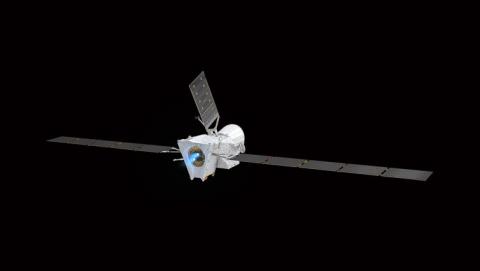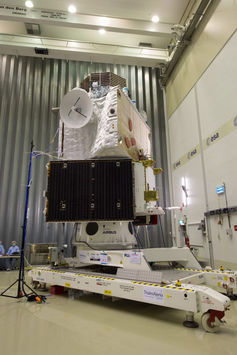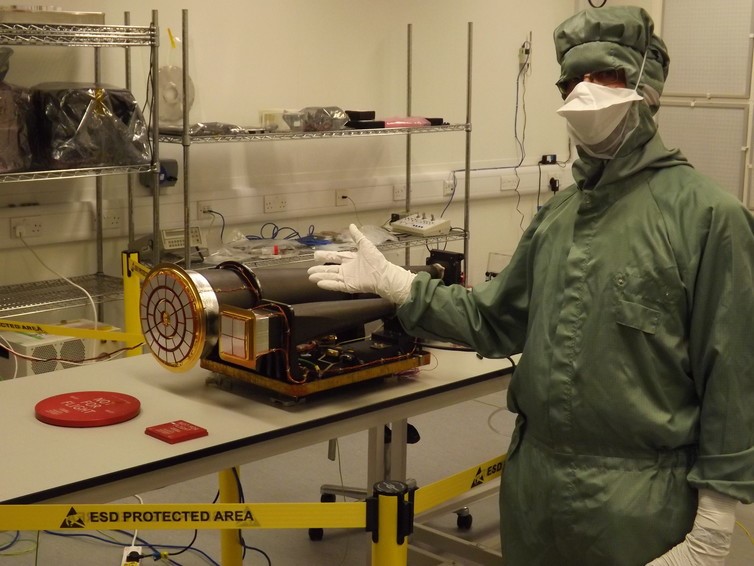The BepiColombo spacecraft is ready to solve the many mysteries of Mercury

The €1.65 billion BepiColombo spacecraft is now being unstacked for final tests after being displayed in its launch configuration to the world’s press at the European Space Agency’s Space Technology and Research Centre. The six-metre high assembly will soon be shipped to Kourou in French Guyana where it is anticipated to launch in October 2018.
This is the culmination of nearly two decades of work by a team of highly motivated scientists and engineers, many of whom I have come to know through my own role on the mission.
 BepiColombo at ESA’s test centre, before a sun shield was placed around the unit at the top. ESA–Philippe Sebirot, CC BY-SA
BepiColombo at ESA’s test centre, before a sun shield was placed around the unit at the top. ESA–Philippe Sebirot, CC BY-SA
BepiColombo is an impressive mission, jointly owned by the European and Japanese space agencies (ESA and JAXA). A European “ion-drive unit” (MTM, Mercury Transfer Module) will propel the assembly during its seven-year cruise before achieving orbit about the sun’s nearest planet. It will fly close past Mercury after less than three years, but will have to continue orbiting the sun, making five more flybys of Mercury – using its gravitational attraction to help it match velocity with the planet so that it can be captured into orbit about the planet itself.
Once in orbit, the Japanese component of the mission, the Mercury Magnetospheric Orbiter, MMO, will be set spinning (for stability) and be released into an eccentric orbit to study the magnetic field, dust and environment of charged particles surrounding the planet. The European orbiter, known as the Mercury Planetary Orbiter, will then lower itself into a more circular orbit optimised for study of the planet’s surface and interior.
Doing science in a pizza oven
The technological challenges of then operating the two vehicles in orbit extend far beyond the sheer “rocket science” of getting there. Mercury is three times closer to the sun than the Earth is, so the spacecraft will be heated by direct sunlight nearly ten times stronger than that experienced above the Earth’s atmosphere. Worse, when flying above the day-side of planet, the orbiter will be baked on its underside by “pizza-oven heat” from Mercury’s searing 400°C surface only 500km below.
BepiColombo’s route to Mercury.
Parts of the spacecraft’s insulated outer surface may reach 380°C at times, but the sensitive electronics inside need to be kept below about -40°C to function properly. Part of the solution has been to fit the orbiter with the splendidly-named “cold finger” – essentially a metal rod which conducts heat from its innards out to where it can be dumped into space via a “venetian blind” radiator panel. The spacecraft’s orientation will be controlled at all times, so that the slats of the panel will never allow direct sunlight or the radiation from the hot planet to fall on the radiator surface.

BepiColombo scientists discussing operational priorities at a team meting in Toulouse, May 2017. D. A. Rothery
This effort scarcely needs to be justified to scientists who are greatly puzzled by what the two previous missions to Mercury – Mariner 10 (1970s) and Messenger (2011-15) – have found.
NASA’s MESSENGER mission revealed that the planet’s surface is surprisingly rich in “volatile” elements such as sulphur, chlorine, sodium and potassium. We would expect these to have been preferentially lost during the hot or violent birth that a planet so close to the sun should have had. Add this to the fact that Mercury’s rocky shell is strangely thin compared to the Earth’s and overlies a disproportionately large iron core, and its very nature poses a conundrum.
It may have originated much further from the sun than we now find it, and suffered a rock-stripping collision during inward migration.
Other questions include why part of Mercury’s core is still molten and able to generate a magnetic field and why the planet shows so much evidence of past volcanic eruptions.
Cost and benefits
Whenever there is a report about a space mission it is usual to see comments from readers bemoaning the waste of money, arguing it ought to have been spent on relieving suffering here on Earth. We can all sympathise with the sentiment, but to single out the costs of space research for censure in this regard lacks a sense of proportion.

Model of the Mercury Imaging X-ray Spectrometer in a clean room at Leicester University. D A Rothery
BepiColombo has cost ESA and JAXA about €1.65 billion between them, not bad for such a complex project, and individual national funding agencies may have spent about the same total again for salaries and instrument development. All this money has been spent on Earth, helping the economy – it hasn’t been somehow shot into space and lost. And in any case new space technology has been shown to open the way for developments such as prostate cancer “sniffer devices” and much more.
Also, let’s not forget that our civilisation disposes of far more of its surplus wealth on entertainment and what might be termed “unnecessary fripperies” than on space research. For example, the annual budgets of the four largest Formula One motor racing teams exceed the total cost to ESA and JAXA for the BepiColombo mission, as do yearly global sales of lipstick.
 So I’m looking ahead to BepiColombo’s findings with a clear conscience. There are many things it can tell us about our part of the solar system. And, perhaps most importantly, it could inspire future generations to take an interest in science.
So I’m looking ahead to BepiColombo’s findings with a clear conscience. There are many things it can tell us about our part of the solar system. And, perhaps most importantly, it could inspire future generations to take an interest in science.
David Rothery, Professor of Planetary Geosciences, The Open University
This article was originally published on The Conversation. Read the original article.
Contact our news team
For all out of hours enquiries, please telephone +44 (0)7901 515891
Contact detailsNews & articles

Research image of the month - a ripple of understanding
This month’s research image of the month (July 2025) encapsulates Carys Jennings' research on how children experience happiness, particularly in a school setting.